The Dragon Bonus (DB) wager is arguably the most common and popular side bet for baccarat on the market. DB allows the gambler to not only wager that either the Banker side or Player side will win, but that the winning side will crush the losing side by a significant number of points. The larger the margin of victory, the larger the payout for the DB wager.
To play DB, a wager is made on the side bet on either the Player or Banker side. The DB wager wins if the side wagered on wins by a natural, or else wins by 4 or more points. The most commonly used pay table is the following:
- Natural win (two card 8 or 9) pays 1-to-1
- Natural tie (two card 8/8 or 9/9) is a push
- Win by 9 pays 30-to-1
- Win by 8 pays 10-to-1
- Win by 7 pays 6-to-1
- Win by 6 pays 4-to-1
- Win by 5 pays 2-to-1
- Win by 4 pays 1-to-1
- All other results lose
The table below gives the combinatorial analysis for this wager. In particular note that the house edge for the Player side of the DB wager is 2.652%, but the house edge for the Banker side of the DB wager is a much larger 9.373%.
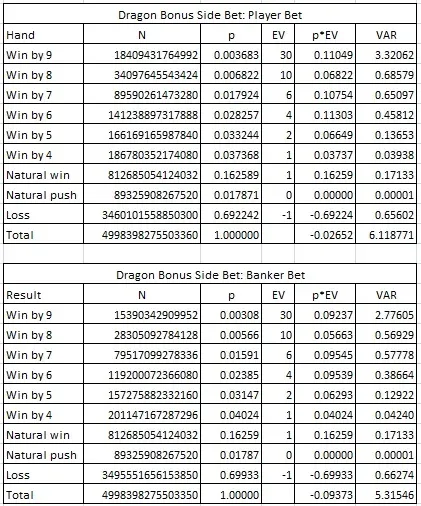
The game of Baccarat is typically dealt very deeply into an eight-deck shoe. It is not unusual to have the cut-card placed 14 cards from the end, yielding very high true counts for just about any card counting system. Given this, just about any side bet will be vulnerable to card counting. DB is no exception.
By considering the house edge of each side (player = 2.652%, banker = 9.373%), the only reasonable approach for the card counting AP is to target the Player side of the DB bet. The following table gives the effect of removal (EOR) for each card for an eight-deck baccarat shoe for the Player side of the DB bet:
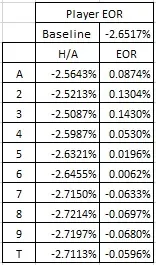
In considering these results, note that the cards that give the highest EOR are the Ace, 2 and 3. Intuitively, the reason for this is that hands that draw a third card cannot win by a large number of points if the draw is an Ace, 2 or 3, making the premium payouts unlikely. On the other hand, the cards 7, 8 and 9 can make big hands on draws, leading to premium payouts. The 8 and 9 also lead to a natural payout. It follows that the 7, 8 and 9 have the most negative EORs.
It is easy to count cards in baccarat because the game is slow and a tracking sheet is allowed at the table. There is no harm in giving card counting indices that would be tough to use at a blackjack table. By multiplying each number in the EOR column by 2098.28, we get the balanced “System 1.” By rounding the values in System 1 and adjusting to get a balanced count, we get “System 2.” These card counting systems are given in the following table:
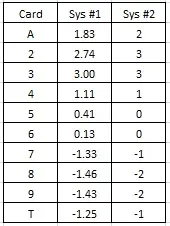
As we will see, System #2 performs fairly well compared to the optimal System 1. To gauge the effectiveness of each, I wrote a computer program to simulate using these two systems in live play. The game I simulated has the following shuffling and cut card rules:
- The game is dealt from a shoe with 8 decks.
- At the start of each shoe, a card is burned. Based on the value of the burn card, an additional number of cards are burned, equal to the value of the card.
- The cut card is placed 14 cards from the end of the shoe.
- After the cut card is dealt, one more round is dealt before shuffling.
The following tables give the results from a simulation of one hundred million (100,000,000) shoes using each system:
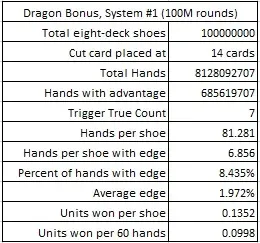
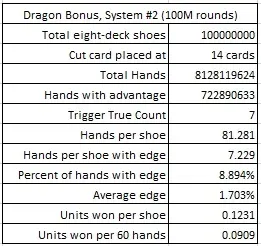
Note that System #1 returns 0.1352 units per shoe, whereas System #2 returns 0.1231 units per shoe. We see that System #2 returns over 91% of the profit obtainable by using an optimal card counting system.
The AP using System #2 should make a DB wager whenever the true count is 7 or higher. In this case, the AP will make a DB bet on approximately 8.89% of the hands dealt. When the AP makes a DB wager, his average edge will be about 1.70%. He will have the edge on about 7.23 hands per shoe.
Baccarat is a slow game. A typical game moves at a pace of about 60 hands per hour. As the table above shows, the AP will earn about 0.0909 units per hour (60 hands). If the maximum bet on DB is $100, then the AP will earn about $9.09 per hour from the DB wager.
These results will hardly instill joy in the itinerant AP. Likewise, there should be little fear of APs attacking this wager by the casino side. But, if there is any concern, then increasing the cut card depth is an ample antidote.
The following table gives card counting statistics for DB for a variety of cut card depths up to two decks. By cutting off 26 cards, the AP’s profit is reduced to $6.74 per hour. At 52 cards (1 deck), the AP’s earning potential has dropped to $3.99 per hour. At 104 cards (2 decks), the AP is ahead about $1.50 per hour.
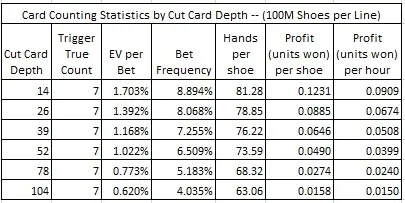
The Dragon Bonus side bet for baccarat is not a significant advantage play opportunity. However, it is beatable. The following are my suggestions for protecting DB:
- Watch for players who only make the DB bet late in the shoe and make table maximum wagers on the Player side.
- Watch for a group of players who all make the DB wager together for a large total amount.
- Watch for players who wager more on the DB bet than on the main game.
- Consider increasing the cut card depth to 26 (or more) cards.
- Consider an alternate pay table for the player side that increases the house edge.


